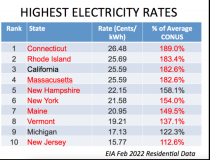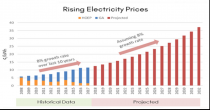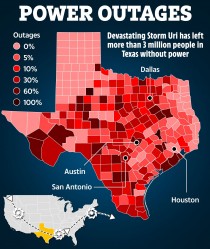Joseph D’Aleo CCM
You may be surprised to find an electric vehicle isn’t a new concept. In the early 1800s, inventors around the world began building electric-powered buggies. In 1890, William Morrison built the first electric car in the U.S. The car could go 14 miles per hour and fit six people. Karl Benz in 1885 invented the first gas-powered car, which he later received a patent for in 1886. Benz’s first car had three wheels, looked much like an elongated tricycle and sat two people.

Four-wheeled gas-powered cars were later introduced in 1891. That marked the beginning of the vehicular evolution in America. But there was one problem with early electric vehicles. People were interested in owning them, but the elaborate machines were too expensive for the middle class.
It wasn’t until Henry Ford’s 1908 Model T that automobiles started to resemble what we’re familiar with today. Thanks to Ford’s invention of the assembly line, the gas-powered Model T could be mass-produced and became affordable for the general population.
It was Henry Ford’s mass-produced Model T that dealt a blow to the electric car. Introduced in 1908, the Model T made gasoline-powered cars widely available and affordable. By 1912, the gasoline car cost only $650, while an electric roadster sold for $1,750.

Other developments also contributed to the decline of the electric vehicle. By the 1920s, the U.S. had a better system of roads connecting cities, and Americans wanted to get out and explore. With the discovery of Texas crude oil, gas became cheap and readily available for rural Americans, and filling stations began popping up across the country. So many people began driving gasoline cars. In comparison, very few Americans outside of cities had electricity at that time and electric vehicles all but disappeared by 1935.
Fast forward to the late 1960s and early 1970s. Soaring oil prices and gasoline shortages—peaking with the 1973 Arab Oil Embargo—created a growing interest in lowering the U.S.’s dependence on foreign oil and finding homegrown sources of fuel.
Automakers began exploring options for alternative fuel vehicles, including electric cars. For example, General Motors developed a prototype for an urban electric car American Motor Company produced electric delivery jeeps that the United States Postal Service used in a 1975 test program. Even NASA helped raise the profile of the electric vehicle when its electric Lunar rover became the first manned vehicle to drive on the moon in 1971.
Yet, the vehicles developed and produced in the 1970s still suffered from drawbacks compared to gasoline-powered cars. Electric vehicles during this time had limited performance—usually topping at speeds of 45 miles per hour—and their typical range was limited to 40 miles before needing to be recharged.
Fast forward again—this time to the 1990s. In the 20 years since the long gas lines of the 1970s, interest in electric vehicles had mostly died down. But new federal and state regulations helped create a renewed interest in electric vehicles in the U.S. Most automakers are focusing on electric and hybrid gas and electric offerings.
EV CARS ARE APPEALING BUT THERE ARE MAJOR CHALLENGES
There are now about 290 million cars registered in the U.S. (here). As of 2020, there were over a million EVs (Electric Vehicles) on the US road (Argonne National Laboratory, 2021). The Edison Electric Institute projected in 2018, that EV stock will reach 18.7 million by 2030.
EVs clearly have benefits. EVs often cost less to maintain because they have fewer and simpler components. They are very quiet. Most provide an exhilarating acceleration experience, thanks to the instant power on tap from the electric motor, or motors. The biggest obstacles for most drivers in addition to the high relative cost are challenges related to the charging.
EVs take a long time to charge. If you don’t drive more than 40-50 miles a day, plugging into a standard “Level 1” 110 volt charger every night could provide enough energy for your daily commute. The standard Level 1 chargers with purchase of an EV add about 2-5 miles of range per hour of charging according to the Department of Energy.
Faster Type 2 charging systems are usually available ‘nearby’ or at your car dealer. Level 2 charging stations have expanded across the country (see).
If not, you can arrange to have level 2 charging station installed at your home. According to the DOE, “the price of Level 2 residential EVSE varies, but typically ranges from $500 to $2,000 before installation and state or utility incentives. Typical charging time for a Level 2 EV charger is around 8 and 10 hours from near empty to full while the average standard Level 1 EV charger will take up to 20 hours to fully charge.”
Kip Hansen warns here “If you need to charge more than 1 car at night home, you may be looking at the rather expensive job of replacing your electrical system from the pole to the main panel (see illustration far above) - new service drop, service point, service entrance wires, service meter (usually supplied by your power company), probably a new service disconnect, and a new service panel. Cost? Up to $5,000.”
The technology will improve with time. DC Fast Electric Charging Stations recharge an EV at a rate of 3 to 20 miles of range per minute. 80% charge in only 20 minutes. But still, full charge may take 1 hour. But importantly, electricity prices will no doubt skyrocket if the move away from hydrocarbon fuels is mandated for automobiles, trucks, businesses, industries and homes.
And you should be aware that as the EIA shows, the cost for electricity varies by state, with the Northeast and California having substantially higher rates than the national average and will feel the pain first and most.

VACATION TRAVEL STRESSES
Right now, EVs are not ideal for drivers with long commutes or even more so for taking long trips - to see Grandma at Thanksgiving, to go to Florida to escape the cold in winter, or a long summer vacation. Planning when and where to charge is a challenge part of any long-distance travel plans. Now with gas cars, we know when we need to exit and fill up. But with EVs, the scarcity of charging stations makes pre-planning a necessity.
Moreover, charging can take hours. Very cold or hot temperatures and cabin climate conditioning reduce driving range and needs to be factored in. Research for the AAA found that when outside temperatures reach 95 degrees F during the summer and AC is used in a vehicle, the driving range can decrease by around 17% and using the heater in an electric vehicle in extreme cold, can reduce the driving range up to 41%. See stories on disappointing range and recharge scarcity disruptions here and here.
CASE STUDY EXAMPLE
My daughter, her husband and three granddaughters took an 11-day post COVID vacation this June from New England south to Florida in a carefully planned trip that covered 3,100 miles in 12 states with stays in 7 hotels in 5 states, visits to 9 parks, amusement park, kayak trips. They filled gas tank 11 times for a total fill time of 55 minutes often at the planned stop or along the highway mostly timed for a meal.
If they had an EV vehicle given the time of year with 90 degree heat, they would have had to stop 19 times to charge and the time to charge could exceed 93 hours! That does not include waiting time for a station. Finding charging stations would require a lot of planning. Even if the temperatures were not extreme (fall or spring weather), the charging would be required 16 times for a total over 77 hours. Some vacation.
For this family adventure, a hybrid would make more sense.
Ironically recall that cheap gasoline and the unavailability of electricity outside big cities a century ago led to the demise of electric vehicles and the gasoline car boom. The charging challenges will lead to ‘resistance’ unless addressed. And the need for truck and off-road (farm, construction, mining, marine, etc) fuel will remain.
Any attempt at a transition to electric in trucking is a huge challenge. 15.5 million trucks operate in the U.S.. Of this figure 2 million are tractor trailer. The United States economy depends on trucks to deliver nearly 70 percent of all freight transported annually in the U.S., accounting for $671 billion worth of manufactured and retail goods transported by truck in the U.S. alone. Add $295 billion in truck trade with Canada and $195.6 billion in truck trade with Mexico. Trucks alter routes to avoid potential storm impacts. Now they will have consider charging challenges. As with every other policy, they are taking steps before technology or needed supplies are ready.
Importantly, Rivian Automotive in a Wall Street Journal story warned that the industry could soon face a shortage of battery supplies for electric vehicles “90% to 95% of the supply chain does not exist.”
BUT WE ARE TOLD “WE MUST ACT NOW TO STOP CLIMATE CHANGE”
The rationale for high gas costs and now is to drive the transition to electric vehicles. They claim that is required to reduce greenhouse related warming and extreme weather.
In the Research Report entitled: On the Validity of NOAA, NASA and Hadley CRU Global Average Surface Temperature Data & The Validity of EPA’s CO2 Endangerment Finding, Abridged Research Report, Dr. James P. Wallace III, Dr. (Honorary) Joseph S. D’Aleo, Dr. Craig D. Idso, June 2017 (here) provided ample evidence that the Global Average Surface Temperature (GAST) data was invalidated for use in climate modeling and for any other climate change policy analysis purpose.
”The conclusive findings of this research are that the three GAST data sets are not a valid representation of reality. In fact, the magnitude of their historical data adjustments, that removed their cyclical temperature patterns, are totally inconsistent with published and credible U.S. and other temperature data. Thus, it is impossible to conclude from the three published GAST data sets that recent years have been the warmest ever - despite current claims of record setting warming.”
See here how all the extremes listed as man caused are explained by natural factors here. The deaths have declined over the last century (EMDAT 2017) not increased as alleged.

THE PRESCRIBED POLICY CHANGES ARE THE REAL DANGERS
For one, instead of diminishing costs and emissions, the changes will cause all forms of energy to skyrocket and it is likely as we see in Europe, it will force power companies to utilize coal as fracking bans limit the availability of clean natural gas. Electricity prices would triple by the end of this decade.

Moreover, the following analysis shows such a forced transition would instead force an increase in the number of power generation and power stations (first guess 25-35%) just to provide the energy for EVs. This would accelerate and magnify price rises.
RENEWABLES ARE NOT DEPENDABLE ENOUGH TO LIGHT THE WAY
With the war on fossil fuels, unreliable wind and solar can’t fill the gap. We saw a preview of that in Texas in 2021 when sub-zero cold and snow hit and knocked out wind power.

In many European nations they learned their lessons from sitting in the cold and dark too often in winter when ‘intermittents’ could not meet demand. They built coal plants for addressing base load demand. They then moved to clean natural gas imported from Russia. A return to coal burning and nuclear plants are planned in the upcoming winter because over interruption of natural gas due to the Russian/Ukraine war. Europe has been down the green path more aggressively and some countries are realizing they may have put the cart before the horse in thinking wind and solar could eliminate hydrocarbon fuel use. They are planning coal usage this winter to keep the lights on in cold outbreaks.
The elitists can afford ways to keep the lights on and house warm. Obama we are told has sought approval to install 3 propane tanks (totaling 2,500 gallons) at his Martha’s Vineyard Estate.
What is your back-up when the lights go out. How far can you drive in your new EV with no way to recharge? If we go down the path the New World Order religion want us to go, the rest of us may find we must go back to candles and horse-drawn carriages.

Resources: ENERGY.GOV here and here, IDRIVESAFELY here. PIWINENERGY.COM here


